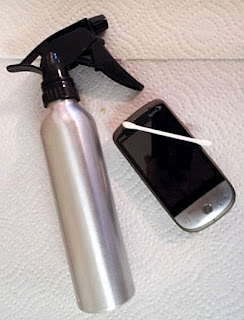CAMERA PHONE PHOTOGRAPHY TIPS
A question I see a lot on the internet is: "How do I take better pictures with my camera-phone when I'm on vacation?" And, though I'd be the last person to tell you to go someplace like Lake Tahoe and NOT bring your good camera; it's still a really good question because great pictures often come up unexpectedly when your good camera is back in your travel bag at the hotel and the one and only shot you'll get at that moment is if you pull out your iPhone and snap a picture right there and then.
| Older camera-phone w/ too little resolution | Newer camera-phone |
|---|---|
 |  |
It used to be that if you snapped a picture with your camera phone, you were stuck with a tiny, low quality image you couldn't do much with, but luckily for those of us who don't carry a pocket camera everywhere, just about all iPhones and most of the newer Android phones come with built-in high definition cameras that can actually take very good pictures if you know how to use them and pay a little attention to to the details of framing and composition. Check out my "How to Take Better Pictures with your Camera Phone" video on My YouTube channel
If you're looking for a phone that takes good pictures, do a little research online, don't just look at the specs on the website, type the model name of the phones you're interested in into YouTube and look at people's test videos and reviews (there are over 6000 results on my phone alone!) , that will give you a much better idea of which phones have decent cameras and which don't. FYI: I took most of the pictures in this blog with a Samsung Galaxy S-II (See Pictures) which has proved far superior to the HTC Hero (See Pictures) I had before.
1. HAVE YOUR CAMERA READY
 The single most common mistake I see in cell phone photography is that people often treat the camera as a secondary part of the phone and don't pay much attention to it: I can't count the number of cell phone pictures I see ruined by a blocked camera or french-fry grease on the lens, or never taken in the first place because the person wasn't familiar with their camera or didn't have the space on the camera's internal drive.
The single most common mistake I see in cell phone photography is that people often treat the camera as a secondary part of the phone and don't pay much attention to it: I can't count the number of cell phone pictures I see ruined by a blocked camera or french-fry grease on the lens, or never taken in the first place because the person wasn't familiar with their camera or didn't have the space on the camera's internal drive. Be sure to keep enough space on the disc in your phone to accomodate a few hundered pictures at all times; hook up to your computer periodicly to offload old pictures and videos so you have enough space to take a picture when you want to, it's better to have one fewer song to listen to than not to be able to take a picture when you get the chance.
 If you use a bumper or case for your cell phone, make a habit of checking with the camera to make sure the camera is not blocked at all. Look around the edge of your screen and if you can see the edge of your case in the shot, you'll know the case isn't on right. Likewise, be aware the camera's location on your phone, hold it by the edge and watch for your fingers to make sure they're not blocking the shot, and pay carefull attention to any other objects (like the mirror on your car door) to make sure they're not hanging in the shot. And if you must take pictures out the car window, make sure the window is down or at least clean!
If you use a bumper or case for your cell phone, make a habit of checking with the camera to make sure the camera is not blocked at all. Look around the edge of your screen and if you can see the edge of your case in the shot, you'll know the case isn't on right. Likewise, be aware the camera's location on your phone, hold it by the edge and watch for your fingers to make sure they're not blocking the shot, and pay carefull attention to any other objects (like the mirror on your car door) to make sure they're not hanging in the shot. And if you must take pictures out the car window, make sure the window is down or at least clean! 2. BEING IN THE RIGHT PLACE AT THE RIGHT TIME
 |
| You can only get the picture if you're in the right place at the right time. |

Keep your awareness open to the world around you, the buildings, the landscape, and the people. Notice the details of things: the little flowers in the landscaping, the detail of the wood and stone... Notice what's special about this particular moment in the world in front of you; the frozen fountain, the spring flower, the sky..
Notice how light plays with the landscape: how the shadows hang on the mountains in the morning, how the light plays off the facades of buildings in the afternoon, how the clouds in the sky refect off of still water.

When you get in the habit of noticing, you will soon find that the world is chock full of stunning images that would make excelent photographs. When you see a good picture in the world, don't be shy! Whip out your camera and take it.
3. VANTAGE POINT
When you see an opportunity for a picture in the world, spend a moment if you can choosing the best place to put your camera for that photograph.
|
|
|
| OK vantage point | Excelent Vantage Point |
|---|---|
 |
Moving around in the scene changes your perspective on whatever it is you're looking at. Different parts of the background will be visible or blocked, or shown in different relationships from different places to stand. As you move notice whether the picture you see in your screen is getting better or worse. Maybe you can see a little more lake in the background if you move a few feet to the right; or avoid having that graffittied up light-pole blocking your view of the beautiful building... You want a clear, unobstructed view of what you're looking at, with nothing ugly or distracting at the edge of the screen. Camera phones take their best pictures up close, so if it's safe to do so get close enough so you can photograph without using the zoom if you can.
| A Dark and moody view | A Bright and Detailed View |
|---|---|
Watch the light and mood changing as you move around searching for a vantage point, oftentimes a movine 60 or 180 degrees around an object gives you an entirely different mood. Taking the pony express statue from the front in full sunlight emphasizes that it's a statue; taking it in shadow with zooming cars in the background emphasizes the action and makes it look as if it could ride off into the sunset right then and there.
4. COMPOSITION
Move around in the place looking at various angles of the thing you're photographing. Look for a spot where the natural lines in the scene (paths, edges of buildings, tree branches, etc.) draw your eye from the edges of picture to a focal point, like where the skiiers are in this photo.
Use the edge of your phone to line it up so that the ground is level, and the buildings, trees, etc. are vertical; then tilt your phone slightly up and down so that the ground level is where you want it to be in the photo. Especialy if there's water in your shot you don't want it to look like the buildings are falling over or the water is about to run out.
Look for a composition that obeys the "rule of thirds": Imagine a pair of lines 1/3 and 2/3 of the way across your picture in either direction, and try to line things up so that things align with those lines (for example: the bottom third of the photo is lake, the middle third mountains, and the top third sky; or putting the trunk of the pine tree at the 2/3 line for a more dynamic tree picture.) If you are taking a picture of a person with a pretty background, they should be placed along the 1/3 line with the other 2/3 taken up with scenery.
 |
| Rule of 3rds |
5. FRAMING
 Once you've found the general angle and placement for your photograph, you should pause at the last moment to make sure the edge of your frame is OK. Check that there are no fingers in the frame, and that the angle is, in fact, missing any ugly things in the vicinity that would spoil your photograph. If you need to use A LITTLE zoom at this point to make the composition work, go ahead and zoom a few percent in or out for the sake of having a better composition or getting something out of the edge of your shot.
Once you've found the general angle and placement for your photograph, you should pause at the last moment to make sure the edge of your frame is OK. Check that there are no fingers in the frame, and that the angle is, in fact, missing any ugly things in the vicinity that would spoil your photograph. If you need to use A LITTLE zoom at this point to make the composition work, go ahead and zoom a few percent in or out for the sake of having a better composition or getting something out of the edge of your shot.
If there's something pretty (like a pine bough or an arch) at the edge of your photograph that might make a good natural frame consider stepping back, zooming out, or angling up/down to include it. If you're not sure, just take the picture both ways and delete the version you like less.
6. DON'T BE AFRAID TO TAKE LOTS OF PICTURES
(and only share the good ones)
The difference between professionals and amateurs is that the professionals don't let you see their failures. Don't be discouraged by the fact that not every picture is spectacular, even if you get really good at photography, only a small fraction of the pictures ever are. Professional photographers take hundereds of pictures when we might take a few dozen, and then go carefully over all the variations and throw away the ones that don't work. If you want a dozen good photos from your vacation, plan to take a hundered pictures while you're out there.
Luckily, on your camera phone the "film" is free and you can take all the pictures you want. Make a habit of looking at the pictures you've just taken and deleting any that are not worth keeping. This will both keep your card free for more pictures on a long trip, prevent you from accidentally sharing anything you wouldn't want seen, and give you the valueable learning experience of noting to yourself why this or that photo didn't work out before you delete it. Are you forgetting to focus? Not noticing that the horizon / buildings aren't level? Also, if you check in the moment you may have the opportunity to replace a photo you're not happy with with another one that dosn't have the same problems.
Instant upload can be a great feature for sharing pictures; since you don't have to be at your computer to share to your social media; but please be selective about what you choose to post. Only share a picture directly if that picture is perfect as it is and not in need of further work; or if the subject matter of the picture requires you to tweet it there and then for news purposes. You should share the few best pictures from your phone each day either singly or in a gallery, but don't try to upload a gallery of more than 4-5 pictures from your cell phone or you'll wind up waiting a long time or maybe going over your data limit. If you're selective and only share the very best pictures, your followers will have a much better opinion of your photography skills.
7. USE YOUR COMPUTER
OK, so you may not have a laptop with you when you're traveling; but when you get home, you should transfer all of the pictures in your phone to the computer. This both gives you a chance to clear your card for the next time and makes sure that if your phone gets lost or damaged you still have your pictures on your computer. Plus, your computer has image editing software that can make a lot of the mediocre pictures you took in the field better.
| Before | After |
|---|---|
For example, in this set we've cropped the ugly buildings out of bottom of the image and taken out some of the tree so that it's used as a framing element, instead of dominating. We've also enhanced the red in the image to make the sunset more spectacular than it originally was and give more of a "purple mountains majesty" effect.
| Before | After |
|---|---|
|
|
|
purple filter and you get the example picture at the top of this blog.
















